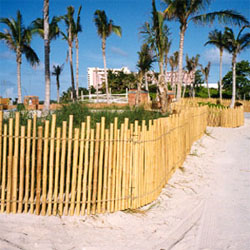One of the best ways to put a unique, interesting touch to your backyard's design is with the use of bamboo fencing. And if you make purchases based on products that are environmentally friendly, bamboo fencing is much better than conventional wood fencing. Bamboo is actually a type of rapidly growing grass and this plant is known for being highly renewable natural resource. If you decide to choose bamboo fencing for your next fence project, rest assured knowing that you will be doing your part to decrease the world's consumption of precious trees and their byproducts.

Selecting the Style of Bamboo Fence
Bamboo fencing is available in a variety of styles. Therefore, selecting the specific type of bamboo fence for your backyard will entirely depend on the look you wish to achieve. In the majority of cases, homeowners will purchase bamboo fencing in panels or rolls. The most common bamboo fence style consists of long poles that measure one-half to one inch in diameter, all of which are constructed together with durable, galvanized stainless steel wire.
However, bamboo fencing rolls are also available in a woven form. This woven bamboo is created by holding together bundles of smaller canes. Split bamboo is another bamboo fence variation. As implied by the name, split bamboo consists of bamboo canes' outer surface, which is tied together using a wire.
Regardless of the bamboo fence style you choose, it is imperative that you think about the product's lifespan. Consider many years of use you want to get from your fence. In the case of pole-and-cane bamboo fences, the lifespan is 20 years. When it comes to split or woven bamboo fences, there is only a lifespan of 10 years.
Putting a Bamboo Fence Over an Existing Fence
If there is already chain-link fencing installed in your yard, you do not have to remove it to make room for a bamboo fence. Instead, you can place rolled bamboo fencing over the preexisting chain-link fencing. In order to do this, you will need to wrap the roll of bamboo around your chain-link fence. Then, use strong, galvanized wire to attach the bamboo roll to the chain-link fence at even intervals.
But if there is a wood fence already in place, and you want to replace it with a bamboo fence, you will need to use split or woven bamboo fencing as opposed to a bamboo roll. When attaching split or woven bamboo to a wood fence, use strong, stainless steel staples.
Stand-Alone Bamboo Fencing
It is much harder to install stand-alone bamboo fencing instead of attaching a bamboo fence onto a preexisting wood panel or chain-link fence. In order to create the necessary vertical framework where the bamboo fence will be put, you must install sturdy, wooden poles first. With a stand-alone bamboo fence, the actual fencing material has to be raised several inches above ground level because bamboo will rot rather quickly when exposed to the moisture in the ground. In addition, the framework poles should be made out of wood in order to reduce the risk of rot.
